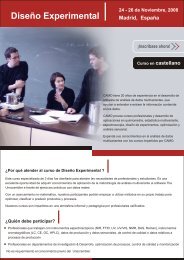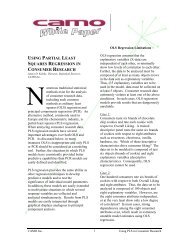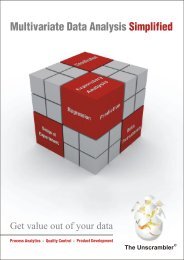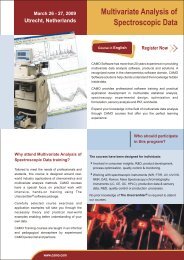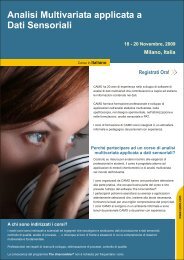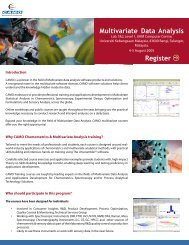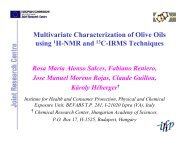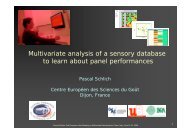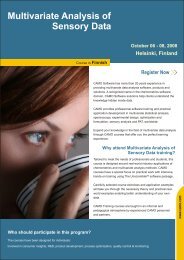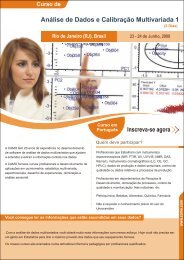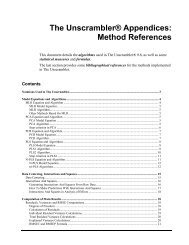Monitoring chemical processes for early fault detection using ... - Camo
Monitoring chemical processes for early fault detection using ... - Camo
Monitoring chemical processes for early fault detection using ... - Camo
Create successful ePaper yourself
Turn your PDF publications into a flip-book with our unique Google optimized e-Paper software.
Makers of<br />
<strong>Monitoring</strong> <strong>chemical</strong> <strong>processes</strong> <strong>for</strong> <strong>early</strong><br />
<strong>fault</strong> <strong>detection</strong> <strong>using</strong> multivariate data<br />
analysis methods<br />
by Dr Frank Westad, Chief Scientific Officer, CAMO Software<br />
Bring data to life
CAMO 02 <strong>Monitoring</strong> <strong>chemical</strong> <strong>processes</strong><br />
CONTENTS<br />
Executive summary .............................................................................................................................................................................................................. 03<br />
About CAMO Software ...................................................................................................................................................................................................... 03<br />
Introduction to Multivariate Process <strong>Monitoring</strong> and Control ......................................................................................................................... 04<br />
Figure 1: Comparing Multivariate and Univariate views of a process .................................................................................................... 05<br />
Common multivariate methods and statistics............................................................................................................................................................. 06<br />
Industry example: Background and Data ................................................................................................................................................................... 07<br />
Table 1: Variables and product attributes in a paper manufacturing process ........................................................................................ 08<br />
Figure 2: The Scores plot to vizualize samples based on all variables .................................................................................................... 09<br />
Figure 3: Line plot of Scores to visualize process trends ........................................................................................................................... 10<br />
Figure 4: Weighted coefficients showing impact of variables on the model ........................................................................................ 10<br />
Figure 5: Predicted values in real-time process monitoring ........................................................................................................................ 11<br />
Figure 6: Hotelling T 2 statistic ............................................................................................................................................................................... 12<br />
Figure 7: Drill down diagnostics <strong>for</strong> out of limit variables ............................................................................................................................ 12<br />
Process optimization .............................................................................................................................................................................................................. 13<br />
Figure 8: Optimizing process settings within given constraints ................................................................................................................ 13<br />
Chart 1: Closed loop process improvement ................................................................................................................................................... 14<br />
Summary ..................................................................................................................................................................................................................................... 14<br />
CAMO Software products and services ......................................................................................................................................................................... 15<br />
> Bring data to life > camo.com
EXECUTIVE SUMMARY<br />
Multivariate statistical methods can be used to monitor process variables<br />
and predict final product quality at an <strong>early</strong> stage, while also providing<br />
deeper understanding of the process. This allows engineers and<br />
production managers to optimize their <strong>processes</strong>, thereby realizing<br />
significant cost and time savings.<br />
This white paper includes a background and explanation of some of the<br />
key multivariate methods, as well as examples of how to interpret typical<br />
multivariate plots. It uses a real-world example from a paper<br />
manufacturing company that was able to improve a key quality parameter,<br />
Print Through, by better understanding the variables impacting it.<br />
Additionally, the company was able to optimize the process going <strong>for</strong>ward,<br />
by adjusting the process inputs to find the ”sweet spot” where the<br />
significant variables affecting quality were all within the acceptable limits.<br />
ABOUT CAMO SOFTWARE<br />
Founded in 1984, CAMO Software is a recognized leader in Multivariate Data Analysis and<br />
Design of Experiments software. Today, we have offices in Norway, USA, Japan, India and<br />
Australia. Multivariate analysis is a powerful set of data mining techniques that help<br />
identify patterns and understand the relationships between variables in large and<br />
complex data sets.<br />
Our software is used by many of the world’s leading companies, universities and research<br />
institutes in the life sciences, food & beverage, agriculture, energy, oil & gas, mining &<br />
metals, industrial manufacturing, pulp & paper, automotive, aerospace and technology<br />
sectors.<br />
The Unscrambler® X software range is a preferred choice of engineers, scientists and data<br />
analysts because of its ease of use, world-leading analytical tools and data visualization.<br />
Our solutions are used by more than 25,000 people in 3,000 organizations to analyze<br />
data, monitor process or equipment per<strong>for</strong>mance and build better predictive models. This<br />
gives them valuable insights to make more in<strong>for</strong>med decisions, improve market<br />
segmentation, research & development, manufacturing <strong>processes</strong> and product quality.<br />
<strong>Monitoring</strong> <strong>chemical</strong> <strong>processes</strong> 03 CAMO<br />
> Bring data to life > camo.com
CAMO 04 <strong>Monitoring</strong> <strong>chemical</strong> <strong>processes</strong><br />
MSPM<br />
Multivariate Statistical<br />
Process <strong>Monitoring</strong><br />
> Bring data to life > camo.com<br />
INTRODUCTION TO MULTIVARIATE PROCESS<br />
MONITORING AND CONTROL<br />
Multivariate Statistical Process <strong>Monitoring</strong> (MSPM) - also referred to as Multivariate<br />
Statistical Process Control or MSPC - is a valuable tool <strong>for</strong> ensuring reliable product<br />
quality in the process industry.<br />
However, many organizations today are still not fully utilizing their potential to make<br />
significant improvements in their production environment. The MSPM approach to<br />
process monitoring involves the use of multivariate models to simultaneously capture the<br />
in<strong>for</strong>mation from as few as two process variables, up to thousands.<br />
The methodology provides major benefits <strong>for</strong> process engineers and production<br />
managers, including:<br />
Increased process understanding<br />
Early <strong>fault</strong> <strong>detection</strong><br />
On-line prediction of quality<br />
Process optimization<br />
With MSPM approaches, it is possible to monitor the data at the final product quality<br />
stage, but also all of the available variables at different stages of the process, to<br />
identify underlying systematic variations in the process.<br />
The variables measured in a process are often correlated to a certain extent, <strong>for</strong> example<br />
when several temperatures are measured in a distillation column. This means that the<br />
events or changes in a process can be visualized in a smaller subspace that may give a<br />
direct <strong>chemical</strong> or physical interpretation. If we want to keep such a process ”in control”,<br />
traditional univariate control charts - due to the covariance or interaction between<br />
variables - may not assure this efficiently. This is because univariate analysis visualizes the<br />
relationship to the response variable one at a time and thus does not reveal the<br />
multivariate patterns between the variables simultaneously, which both <strong>for</strong> interpretation<br />
and prediction are vital <strong>for</strong> industrial <strong>processes</strong>.
<strong>Monitoring</strong> <strong>chemical</strong> <strong>processes</strong> 05 CAMO<br />
Figure 1 exemplifies a typical situation where two process variables are both inside their<br />
univariate control limits (given as two standard deviation) but fails to detect that the<br />
general trend of correlation between these two variables is broken <strong>for</strong> the sample shown<br />
in red.<br />
Figure 1.<br />
In many <strong>processes</strong>, the variables have important interactions<br />
affecting the outcome (e.g. final product quality) which cannot be<br />
detected by traditional univariate statistical process control charts.<br />
Comparing Univariate and Multivariate views of a simple process involving only two variables,<br />
Temperature and pH. In this case, the sample appears to be in specification when seen with two<br />
separate univariate control charts (Temperature Control Chart and pH Control Chart) but is actually<br />
out of specification when seen with the Multivariate view.<br />
6<br />
5.8<br />
5.6<br />
5.4<br />
5.2<br />
5<br />
4.8<br />
4.6<br />
23<br />
Temperature Control Chart<br />
23<br />
25<br />
Multivariate view<br />
25 27 29 31 33 35 37<br />
27<br />
29<br />
31<br />
Temperature (c)<br />
33<br />
35<br />
1 6 11 16 21 26 31 36 41 46 51<br />
37<br />
Time(min)<br />
pH<br />
6<br />
5.8<br />
5.6<br />
5.4<br />
5.2<br />
5<br />
4.8<br />
pH Control Chart<br />
4.6<br />
1 6 11 16 21 26 31 36 41 46 51<br />
Time(min)<br />
Only with multivariate analysis can the <strong>fault</strong> be detected<br />
The univariate limits are too wide to detect a multivariate <strong>fault</strong><br />
The two variables under consideration are not independent<br />
The "sweet spot" is defined by the ellipse<br />
Multivariate analysis<br />
Multivariate data analysis (MVA) is the analysis of more than one variable at a time. Essentially, it is a<br />
tool to find patterns and relationships between several variables simultaneously. It lets us predict the<br />
effect a change in one or more variables will have on other variables. Multivariate analysis methods<br />
include exploratory data analysis (data mining), classification (e.g. cluster analysis),<br />
regression analysis and predictive modelling.<br />
Univariate analysis<br />
Univariate analysis is the simplest <strong>for</strong>m of quantitative (statistical) analysis. The analysis is carried out<br />
with the description of a single variable and its attributes of the applicable unit of analysis.<br />
Univariate analysis is also used primarily <strong>for</strong> descriptive purposes, while multivariate analysis is<br />
geared more towards explanatory purposes. Source: Wikipedia<br />
> Bring data to life > camo.com
CAMO 06 <strong>Monitoring</strong> <strong>chemical</strong> <strong>processes</strong><br />
> Bring data to life > camo.com<br />
COMMON MULTIVARIATE METHODS AND STATISTICS<br />
The most frequently applied multivariate methods are Principal Component Analysis<br />
(PCA) and Partial Least Squares Regression (PLSR).<br />
PCA answers the question “Is the process under control?” but does not provide a<br />
quantitiave model <strong>for</strong> the final product quality. Typical applications of PCA <strong>for</strong> this<br />
purpose are raw material identification and on-line testing of product quality.<br />
In addition to the monitoring aspect, PLS Regression also provides quantitative<br />
prediction of the final product quality based on all or a subset of the process variables.<br />
One vital aspect in this context is to reduce the off-line laboratory work, both to have the<br />
prediction at an <strong>early</strong> stage as the product properties are not available on-line, and to<br />
reduce the labour-intensive work.<br />
Critical statistical limits can be derived from the empirical data chosen to establish a<br />
model <strong>for</strong> when the process is under control. One limit is based on the space defined by<br />
the model, the so-called Hotelling T2 statistic. This statistic indicates if there is too high or<br />
too low concentration of the quality variable of interest. The other limit is based on the<br />
distance to the model, meaning there is something new e.g. there is a change in the raw<br />
material.<br />
Multivariate statistical methods are also excellent tools to develop <strong>processes</strong> further.<br />
With these methods we can look inside the process to gain the necessary in<strong>for</strong>mation <strong>for</strong><br />
optimizing them.<br />
Principal Component Analysis (PCA)<br />
A method <strong>for</strong> analyzing variability in data. PCA does this by separating the data into Principal<br />
Components (PCs). Each PC contributes to explaining the total variability, with the first PC describing<br />
the greatest source of variability. The goal is to describe as much of the in<strong>for</strong>mation in the system as<br />
possible in the fewest number of PCs and whatever is left can be attributed to noise i.e. no<br />
in<strong>for</strong>mation. Maps of samples (scores) and variables (loadings) give valuable in<strong>for</strong>mation of the<br />
underlying data structures.<br />
Partial Least Squares Regression (PLSR)<br />
A method <strong>for</strong> relating the variations in one or several response variables (Y-variables) to the<br />
variations of several predictors (X-variables), with explanatory or predictive purposes.
INDUSTRY EXAMPLE: BACKGROUND AND DATA<br />
<strong>Monitoring</strong> <strong>chemical</strong> <strong>processes</strong> 07 CAMO<br />
A paper producer monitors the quality of newsprint by applying ink to one side of the<br />
paper. By measuring the reflectance of light on the reverse side of the paper, a reliable,<br />
practical measure of how visible the ink is on the opposite side is obtained. This property,<br />
Print Through, is an important quality parameter. The paper is also analyzed with regard<br />
to several other product variables and raw material variables.<br />
The data used in this example is taken from a real-world paper manufacturing process.<br />
Samples were collected from the production line over a considerable period of time to<br />
ensure the measurements would capture the important variations in production.<br />
Model<br />
A model is a mathematical equation summarizing variations in a data set. Models are built so that<br />
the structure of a data table can be understood better than by just looking at all raw values.<br />
Statistical models consist of a structure part and an error part. The structure part (in<strong>for</strong>mation) is<br />
intended to be used <strong>for</strong> interpretation or prediction, and the error part (noise) should be as small as<br />
possible <strong>for</strong> the model to be reliable.<br />
Calibration<br />
Stage of data analysis where a model is established with the available data, so that it describes the<br />
data as well as possible. It is imperative that this is based on model validation and not the best<br />
numerical fit.<br />
After calibration, the variation in the data can be expressed as the sum of a modelled part (structure)<br />
and a residual part (noise). ’Calibration samples’ are the samples on which the calibration is based.<br />
The variation observed in the variables measured on the calibration samples provides the in<strong>for</strong>mation<br />
that is used to build the model. If the purpose of the calibration is to build a model that will<br />
later be applied on new samples <strong>for</strong> prediction, it is important to collect calibration samples that<br />
span the variations expected in the future prediction samples.<br />
Prediction<br />
Predictions are per<strong>for</strong>med by collecting new samples, obtain the values <strong>for</strong> the variables with the<br />
appropriate sensors similarly as in the calibration stage and apply the model to give a prediction<br />
(estimate) of the product quality. The multivariate methods also have diagnostics <strong>for</strong> detecting<br />
outliers at the prediction stage.<br />
> Bring data to life > camo.com
CAMO 08 <strong>Monitoring</strong> <strong>chemical</strong> <strong>processes</strong><br />
> Bring data to life > camo.com<br />
The data consists of 66 samples with 15 process and product attribute variables and the<br />
response variable, Print Through. In this case, 16 of the samples were test samples used<br />
<strong>for</strong> prediction <strong>using</strong> the model based on the calibration data of 50 samples. The process<br />
variables are given in Table 1.<br />
Table 1.<br />
Variables and product attributes in a paper manufacturing process<br />
which determine quality.<br />
X-var Name Description<br />
X1 Weight Weight / sq. m<br />
X2 Ink Amount of Ink<br />
X3 Brightness Brightness of the paper<br />
X4 Scatter Light scattering coefficient<br />
X5 Opacity Opacity of the paper<br />
X6 Roughness Surface roughness of the paper<br />
X7 Permeability Permeability of the paper<br />
X8 Density Density of the paper<br />
X9 PPS Parker Print Surf number<br />
X10 Oil absorb A measure of the paper’s ability to absorb oil<br />
X11 Ground wood The % of ground wood pulp in the paper<br />
X12 Thermo pulp The % of thermomechanical pulp<br />
X13 Waste paper The % of recycled paper<br />
X14 Magenf The amount of additive<br />
X15 Filler The % of filler<br />
The purpose was to establish a model that could be used <strong>for</strong> quality control and<br />
production management. The objectives were:<br />
Predict quality from the process variables and other product variables<br />
Rationalize the quality control process by reducing the number of variables<br />
measured i.e. build a model that includes a subset of variables without losing the<br />
underlying variability<br />
Using The Unscrambler® X multivariate analysis software, a PLS regression model was<br />
run with 50 calibration samples and the 15 process and product variables with Print<br />
Through as the response variable. As mentioned above, an important aspect of<br />
multivariate modelling is that the dimensionality of the process is typically lower than the<br />
number of process variables measured i.e. there is a redundancy among the observed<br />
variables.
<strong>Monitoring</strong> <strong>chemical</strong> <strong>processes</strong> 09 CAMO<br />
This is exemplified in the Scores plot in Figure 2 which summarises the model in the two<br />
underlying dimensions (“factors” or “latent variables”) <strong>for</strong> the 15 original process<br />
variables. There<strong>for</strong>e, rather than plotting the individual variables in one, two or three<br />
dimensions, the process can be visualized as a map of the samples in the latent variable<br />
space, the Scores plot. The corresponding Loadings plot (not shown) visualizes the<br />
relationships between all variables.<br />
Figure 2.<br />
The Scores plot is used to visualize the samples based on all<br />
variables.<br />
The Scores plot <strong>for</strong> Factors 1 & 2 in a paper manufacturing process. In this case, the fact the samples<br />
(dots) are evenly and widely scattered indicates there are no clear groupings or outliers, which is a<br />
positive result in this instance. However, the timeline in the process can been seen from left to right<br />
as shown in Figure 3. The ellipse defines the 95% confidence limit.<br />
The Scores plot<br />
A Scores plot represents each sample in the space defined by a particular Principal Component.<br />
They can be plotted as line plots <strong>for</strong> describing sample trends, or 2D or 3D scatter plots <strong>for</strong> defining<br />
trends and visualizing clusters.<br />
> Bring data to life > camo.com
CAMO 10 <strong>Monitoring</strong> <strong>chemical</strong> <strong>processes</strong><br />
> Bring data to life > camo.com<br />
Alternatively one may visualise the change in the process over time as a one-dimensional<br />
Scores plot if such a clear trend exists, as shown in Figure 3.<br />
Figure 3.<br />
A line plot of Scores can be used to visualize trends and<br />
developments in a process over time.<br />
The line plot of Scores <strong>for</strong> Factor 1 cl<strong>early</strong> shows the change over time towards higher Scores, as<br />
seen by the upwards trend. In this case this corresponds to higher quality.<br />
The overall importance of the process variables are most easily depicted in terms of the<br />
model coefficients as shown in Figure 4.<br />
Figure 4.<br />
Weighted regression coefficients show which of the variables have a<br />
significant impact on the model in terms of the final product<br />
quality.<br />
The bars with the diagonal lines are those that have a significant relationship to Print Through.<br />
The model shows that Weight, Scatter, Opacity and Filler have an inverse relationship to Print<br />
Through (e.g. the lower the weight the higher the Print Through), while Print Through increases with<br />
increased Brightness. Where the bars are blue, there is no significant relationship, or there is high<br />
uncertainty, as indicated by the ’I’ shaped confidence interval lines.<br />
Figure 4. The model summarised in terms of the regression coe�cients with signi�cant variables marked.
<strong>Monitoring</strong> <strong>chemical</strong> <strong>processes</strong> 11 CAMO<br />
While validating the model robustness, a 95% confidence interval is estimated <strong>for</strong> each<br />
variable, thus indicating which variables are important. The practical benefit of this is that<br />
if many variables describe the model in the same way, it is not necessary to measure all<br />
of them. Of course, one may decide to continue monitoring all the variables but not to<br />
use them <strong>for</strong> prediction if the parsimonious (most simplistic version possible) model is<br />
better <strong>for</strong> that purpose.<br />
From the results of the first model, a reduced model with only five variables was chosen<br />
<strong>for</strong> on-line prediction <strong>using</strong> the variables which were shown to be significant:<br />
Weight<br />
Brightness<br />
Scatter<br />
Opacity<br />
Filler<br />
Using the Unscrambler® X Process Pulse real-time process monitoring software,<br />
process operators or engineers can view interactive plots during the prediction stage<br />
which give insight into any changes in the process. Upper and lower control limits <strong>for</strong> the<br />
print through are shown in real-time (Figure 5) and <strong>using</strong> the Hotelling T2 statistic<br />
(Figure 6 overleaf).<br />
Hotelling T² statistic<br />
A linear function of the leverage that can be compared to a critical limit according to an F-test. This<br />
statistic is useful <strong>for</strong> the <strong>detection</strong> of outliers at the modelling or prediction stage. The ’Hotelling T²<br />
ellipse’ is a 95% confidence ellipse which can be included in scores plots and reveals potential<br />
outliers, lying outside the ellipse.<br />
Figure 5.<br />
Predicted values: Multivariate methods allow the quality variable<br />
to be represented by simple upper and lower limits <strong>using</strong> a model<br />
based on all five 5 input variables, above.<br />
This chart shows the predicted values <strong>for</strong> Print Through. In this case, Sample 14 is out of<br />
specification (above the red critical limit line), indicating a problem with the process. See Figure 7 <strong>for</strong><br />
further explanation.<br />
> Bring data to life > camo.com
CAMO 12 <strong>Monitoring</strong> <strong>chemical</strong> <strong>processes</strong><br />
Figure 6.<br />
> Bring data to life > camo.com<br />
Hotelling T 2 statistic: Critical limits<br />
The model shows a univariate representation of the confidence ellipse shown in Figure 2.<br />
Using the Unscrambler® X Process Pulse, when a new sample falls outside the critical<br />
limit the process operator or engineer can simply click on the suspect data point in the<br />
plot to immediately see which variable is outside the limits as defined by the calibration<br />
(Figure 7).<br />
Figure 7.<br />
The diagnostics in Process Pulse allow the process operator to ’drill<br />
down’ and identify the specific variables which are out of limit in a<br />
sample.<br />
After drilling down into Sample 14, the process operator can see that Opacity and Scatter are<br />
outside the min and max limits from the calibration, illustrated by the red dot below the blue min<br />
and max lines.<br />
Figure 7. Plot of sample 14 showing Opacity and Scatter being outside the min and max from the calibration
PROCESS OPTIMIZATION<br />
Once a model has been established the next step may be optimization of the process<br />
with constraints on the process variables as well as the product quality.<br />
In this case, some constraints were given <strong>for</strong> the five important variables in the final<br />
model, while at the same time the target range <strong>for</strong> the Print Through was set to be<br />
between 35 and 40.<br />
<strong>Monitoring</strong> <strong>chemical</strong> <strong>processes</strong> 13 CAMO<br />
Figure 8 shows the result of the optimisation <strong>using</strong> the Unscrambler® Optimizer<br />
software. It is also possible to add interaction and square terms but this was not pursued<br />
in detail as there were no indications that such additional model terms improved the<br />
model.<br />
Figure 8.<br />
Optimization software enables manufacturers to choose the best<br />
process setting within specified constraints.<br />
By setting the upper and lower limits <strong>for</strong> the five key process variables, as defined by the earlier<br />
analysis, they are then able to identify the optimial process settings given the specifed constraints<br />
<strong>using</strong> Unscrambler® Optimizer software.<br />
Figure 8. Optimization given constraints on the process variables and target range<br />
In this case, the paper manufacturer was able to:<br />
Identify the critical process variables affecting Print Through<br />
Implement real-time process monitoring enabling them to fix possible failures at<br />
an <strong>early</strong> stage<br />
Optimize the process <strong>using</strong> their newfound understanding of its behaviour<br />
Improve end product quality and reduce scrap, re-work and energy costs<br />
> Bring data to life > camo.com
CAMO 14 <strong>Monitoring</strong> <strong>chemical</strong> <strong>processes</strong><br />
Chart 1.<br />
> Bring data to life > camo.com<br />
Process overview.<br />
Better process understanding can result in major cost and efficiency improvements relatively quickly.<br />
When combined with the knowledge and experience of in-house production teams, multivariate<br />
data analysis tools can give manufacturers much deeper insights into process behavior than<br />
traditional univariate statistics. These tools can be applied from the initial data analysis stage<br />
through to optimization of critical process parameters and the knowledge gained transferred to<br />
other <strong>processes</strong>.<br />
Technology and<br />
Knowledge<br />
Transfer to future<br />
<strong>processes</strong><br />
Optimize process<br />
based on better<br />
understanding<br />
and control<br />
SUMMARY<br />
Analyse historic<br />
data to determine<br />
the critical<br />
variables<br />
Closed-loop<br />
process<br />
improvement<br />
Process Pulse<br />
enables real-time<br />
identification and<br />
control of out of<br />
limit variables<br />
Develop a<br />
calibration model<br />
that explains when<br />
a process is in<br />
specification<br />
Apply the<br />
predictive<br />
(calibration) model<br />
to on-line process<br />
monitoring<br />
Multivariate methods are a powerful and efficient tool in monitoring process variables as<br />
well as <strong>for</strong> predicting final product quality at an <strong>early</strong> stage. For complex <strong>processes</strong><br />
involving several variables interacting, multivariate statistical process monitoring (MSPM)<br />
methods are considerably more effective than univariate control charts. They enable the<br />
identification of the process “sweet-spot”, while disturbances in the process can easily be<br />
detected and the variables ca<strong>using</strong> the upset can be interactively spotted in the on-line<br />
monitoring phase.<br />
Importantly, process operators do not need to understand the methodology behind the<br />
system, as the plot of the original process variables is shown on screen. The concept of<br />
MSPM can also be extended to hierarchical models <strong>for</strong> classification and prediction of<br />
raw material quality in a complete production process quality system.
CAMO SOFTWARE<br />
PRODUCTS & SERVICES<br />
Our powerful yet easy to use and af<strong>for</strong>dable solutions are applied around the world in a<br />
wide range of industries<br />
The Unscrambler ® X<br />
Leading multivariate analysis software used by thousands of<br />
data analysts around the world every day. Includes powerful<br />
regression, classification and exploratory data analysis tools.<br />
TRIAL VERSION READ MORE<br />
Unscrambler ® X Prediction Engine<br />
& Classification Engine<br />
Software integrated directly into analytical or scientific<br />
instruments <strong>for</strong> real-time predictions and classifications<br />
directly from the instruments <strong>using</strong> multivariate models.<br />
TRIAL VERSION READ MORE<br />
Training<br />
Our experienced, professional trainers can help your<br />
team use multivariate analysis to get more value from<br />
your data. Classroom, online or tailored in-house training<br />
courses from beginner to expert levels available.<br />
READ MORE CONTACT US<br />
Find out more<br />
For more in<strong>for</strong>mation please contact your regional<br />
CAMO office or email sales@camo.com<br />
www.camo.com<br />
NORWAY<br />
Nedre Vollgate 8,<br />
N-0158<br />
Oslo<br />
Tel: (+47) 223 963 00<br />
Fax: (+47) 223 963 22<br />
© 2012 CAMO Software AS<br />
USA<br />
One Woodbridge Center<br />
Suite 319, Woodbridge<br />
NJ 07095<br />
Tel: (+1) 732 726 9200<br />
Fax: (+1) 973 556 1229<br />
INDIA<br />
14 & 15, Krishna Reddy<br />
Colony, Domlur Layout<br />
Bangalore - 560 071<br />
Tel: (+91) 80 4125 4242<br />
Fax: (+91) 80 4125 4181<br />
Unscrambler ® X Process Pulse<br />
Real-time process monitoring software that lets you predict,<br />
identify and correct deviations in a process be<strong>for</strong>e they become<br />
problems. Af<strong>for</strong>dable, easy to set up and use.<br />
TRIAL VERSION READ MORE<br />
Consultancy and Data Analysis Services<br />
Do you have a lot of data and in<strong>for</strong>mation but don’t have<br />
resources in house or time to analyze it? Our consultants<br />
offer world-leading data analysis combined with hands-on<br />
industry expertise.<br />
READ MORE CONTACT US<br />
Our partners<br />
CAMO Software works with a wide range of instrument and<br />
system vendors. For more in<strong>for</strong>mation please contact your<br />
regional CAMO Software office or visit<br />
www.camo.com/partners<br />
Did you find this useful? Send it to a friend<br />
or share it in your network.<br />
JAPAN<br />
Shibuya 3-chome Square Bldg 2F<br />
3-5-16 Shibuya Shibuya-ku<br />
Tokyo, 150-0002<br />
Tel: (+81) 3 6868 7669<br />
Fax: (+81) 3 6730 9539<br />
AUSTRALIA<br />
PO Box 97<br />
St Peters<br />
NSW, 2044<br />
Tel: (+61) 4 0888 2007



